
Aerospace and defense company Huntington Ingalls (NYSE:HII) fell short of the market’s revenue expectations in Q1 CY2025, with sales falling 2.5% year on year to $2.73 billion. Its GAAP profit of $3.79 per share was 31.4% above analysts’ consensus estimates.
Is now the time to buy Huntington Ingalls? Find out by accessing our full research report, it’s free.
Huntington Ingalls (HII) Q1 CY2025 Highlights:
- Revenue: $2.73 billion vs analyst estimates of $2.79 billion (2.5% year-on-year decline, 2.1% miss)
- EPS (GAAP): $3.79 vs analyst estimates of $2.88 (31.4% beat)
- Operating Margin: 5.9%, in line with the same quarter last year
- Free Cash Flow was -$462 million compared to -$274 million in the same quarter last year
- Backlog: $48 billion at quarter end, in line with the same quarter last year
- Market Capitalization: $9.04 billion
“We are encouraged by the pace of our operational initiatives in 2025. We expect throughput to ramp as we move through the year and, coupled with our cost savings initiatives, we expect steady improvement in support of our operational and financial goals. We are also very supportive of the administration's commitment to expand our nation's shipbuilding capabilities and the maritime industrial base," said Chris Kastner, HII’s president and CEO.
Company Overview
Building Nimitz-class aircraft carriers used in active service, Huntington Ingalls (NYSE:HII) develops marine vessels and their mission systems and maintenance services.
Sales Growth
A company’s long-term sales performance can indicate its overall quality. Any business can put up a good quarter or two, but the best consistently grow over the long haul. Regrettably, Huntington Ingalls’s sales grew at a tepid 4.8% compounded annual growth rate over the last five years. This was below our standard for the industrials sector and is a tough starting point for our analysis.
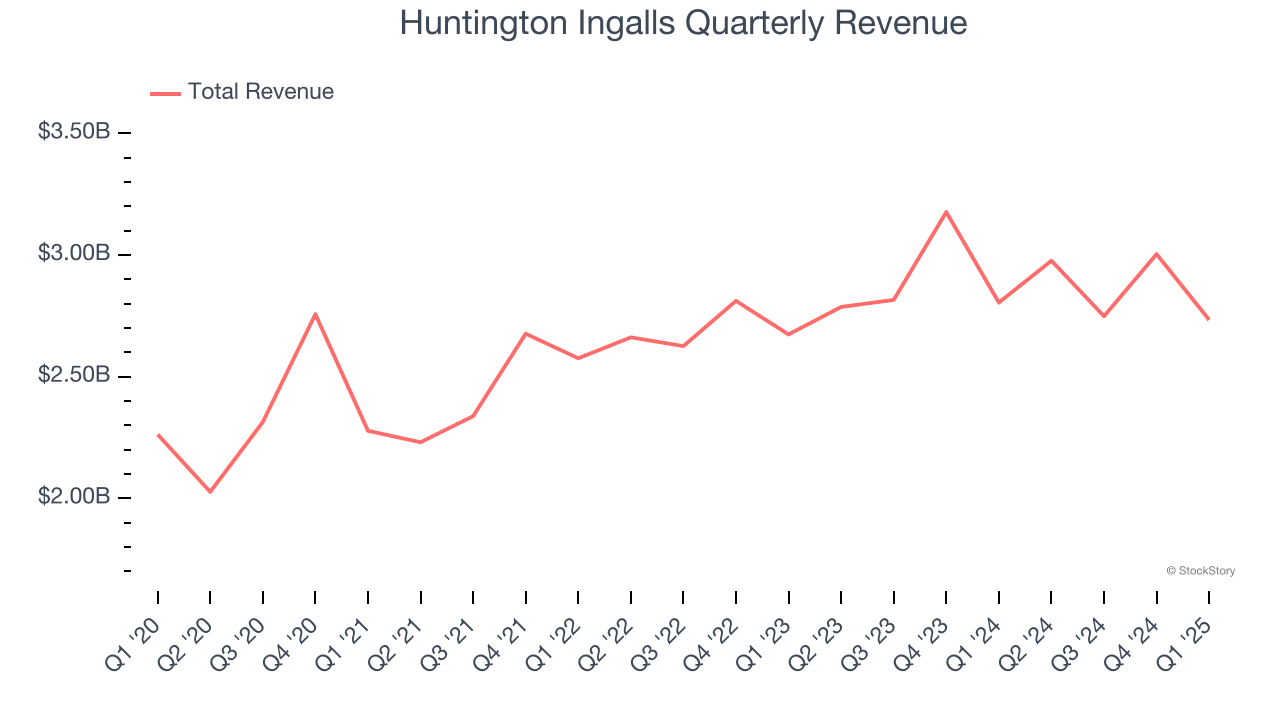
We at StockStory place the most emphasis on long-term growth, but within industrials, a half-decade historical view may miss cycles, industry trends, or a company capitalizing on catalysts such as a new contract win or a successful product line. Huntington Ingalls’s recent performance shows its demand has slowed as its annualized revenue growth of 3.2% over the last two years was below its five-year trend. 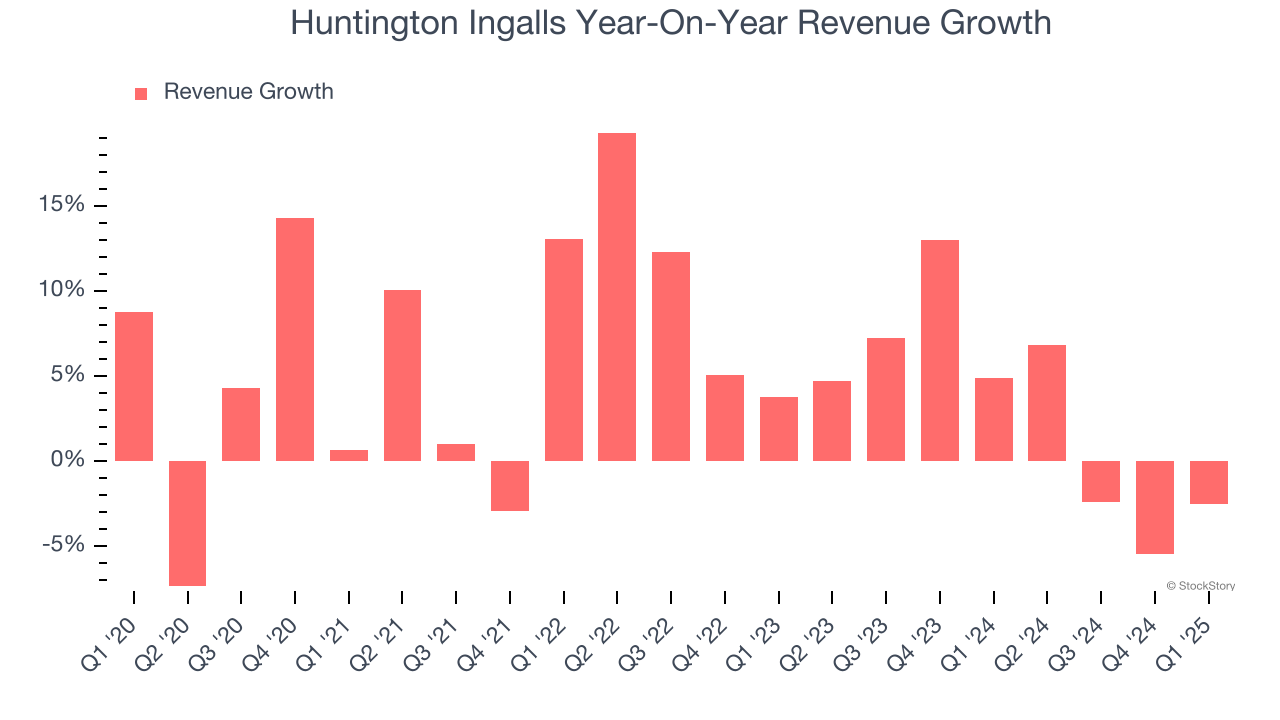
Huntington Ingalls also reports its backlog, or the value of its outstanding orders that have not yet been executed or delivered. Huntington Ingalls’s backlog reached $48 billion in the latest quarter and averaged 1.8% year-on-year growth over the last two years. Because this number is in line with its revenue growth, we can see the company effectively balanced its new order intake and fulfillment processes. 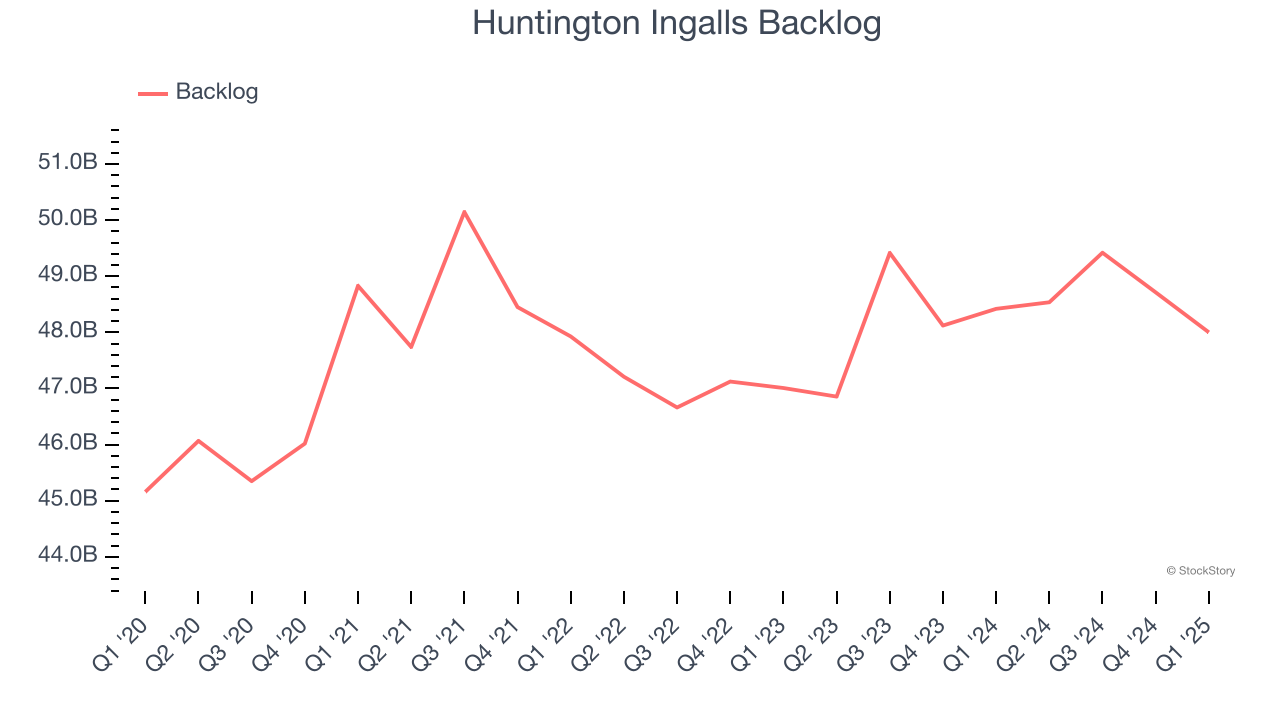
This quarter, Huntington Ingalls missed Wall Street’s estimates and reported a rather uninspiring 2.5% year-on-year revenue decline, generating $2.73 billion of revenue.
Looking ahead, sell-side analysts expect revenue to grow 5.2% over the next 12 months. Although this projection implies its newer products and services will spur better top-line performance, it is still below the sector average.
Today’s young investors won’t have read the timeless lessons in Gorilla Game: Picking Winners In High Technology because it was written more than 20 years ago when Microsoft and Apple were first establishing their supremacy. But if we apply the same principles, then enterprise software stocks leveraging their own generative AI capabilities may well be the Gorillas of the future. So, in that spirit, we are excited to present our Special Free Report on a profitable, fast-growing enterprise software stock that is already riding the automation wave and looking to catch the generative AI next.
Operating Margin
Huntington Ingalls was profitable over the last five years but held back by its large cost base. Its average operating margin of 5.9% was weak for an industrials business.
Analyzing the trend in its profitability, Huntington Ingalls’s operating margin decreased by 3.1 percentage points over the last five years. This raises questions about the company’s expense base because its revenue growth should have given it leverage on its fixed costs, resulting in better economies of scale and profitability. Huntington Ingalls’s performance was poor no matter how you look at it - it shows that costs were rising and it couldn’t pass them onto its customers.
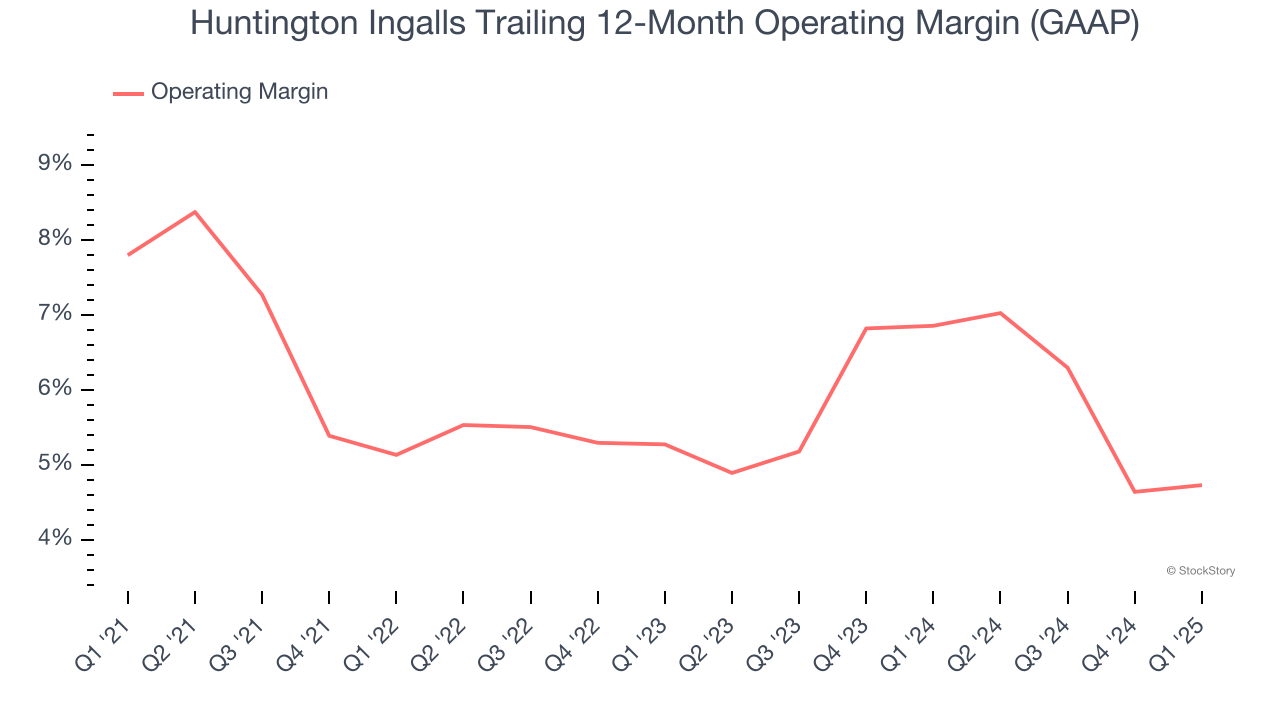
In Q1, Huntington Ingalls generated an operating profit margin of 5.9%, in line with the same quarter last year. This indicates the company’s overall cost structure has been relatively stable.
Earnings Per Share
Revenue trends explain a company’s historical growth, but the long-term change in earnings per share (EPS) points to the profitability of that growth – for example, a company could inflate its sales through excessive spending on advertising and promotions.
Sadly for Huntington Ingalls, its EPS declined by 1.1% annually over the last five years while its revenue grew by 4.8%. This tells us the company became less profitable on a per-share basis as it expanded due to non-fundamental factors such as interest expenses and taxes.
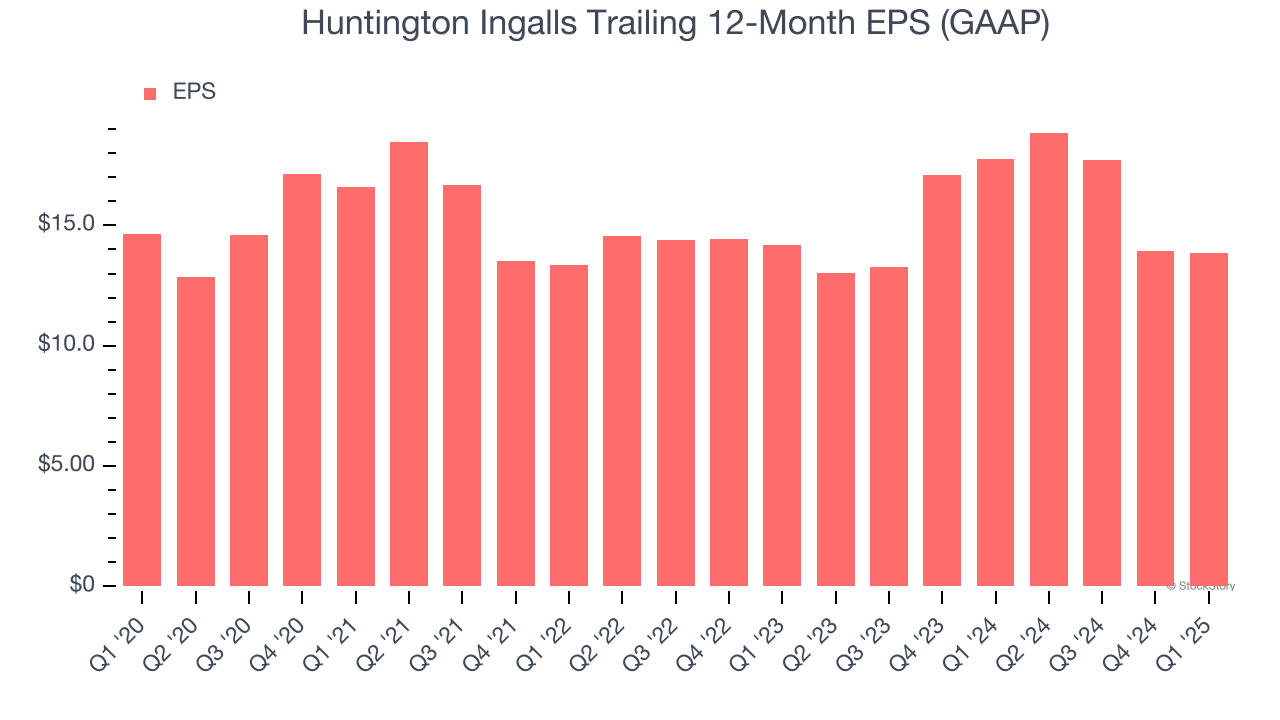
We can take a deeper look into Huntington Ingalls’s earnings to better understand the drivers of its performance. As we mentioned earlier, Huntington Ingalls’s operating margin was flat this quarter but declined by 3.1 percentage points over the last five years. This was the most relevant factor (aside from the revenue impact) behind its lower earnings; taxes and interest expenses can also affect EPS but don’t tell us as much about a company’s fundamentals.
Like with revenue, we analyze EPS over a more recent period because it can provide insight into an emerging theme or development for the business.
For Huntington Ingalls, its two-year annual EPS declines of 1.1% are similar to its five-year trend. These results were bad no matter how you slice the data.
In Q1, Huntington Ingalls reported EPS at $3.79, down from $3.87 in the same quarter last year. Despite falling year on year, this print easily cleared analysts’ estimates. Over the next 12 months, Wall Street expects Huntington Ingalls’s full-year EPS of $13.87 to grow 5.4%.
Key Takeaways from Huntington Ingalls’s Q1 Results
We were impressed by how significantly Huntington Ingalls blew past analysts’ EPS expectations this quarter. On the other hand, its revenue missed. Overall, this quarter could have been better. The stock traded down 2.7% to $223.65 immediately following the results.
Is Huntington Ingalls an attractive investment opportunity at the current price? If you’re making that decision, you should consider the bigger picture of valuation, business qualities, as well as the latest earnings. We cover that in our actionable full research report which you can read here, it’s free.
